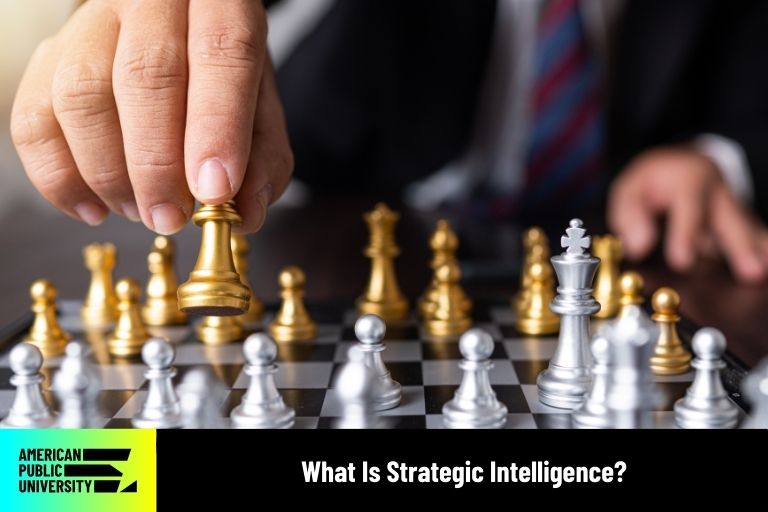09/29/2025

Building Organizational Strength Through Informed Strategy
In a fast-moving business environment, reacting to change isn’t enough. Organizations need foresight: the ability to anticipate shifts, recognize patterns, and respond with purpose. That’s where strategic intelligence comes in. This practice goes beyond gathering data. It connects insight with action, helping leaders make decisions that align with broader goals.
Strategic intelligence supports organizations as they work toward strategic objectives, improve their competitive edge, and navigate market complexity. For students studying business, public policy, or national security, exploring strategic intelligence may offer insights into how analysis supports planning. These concepts can be observed across a range of sectors, depending on individual roles and contexts.
Explore the essential elements of strategic intelligence, its integration into planning, the role of artificial intelligence, and how these tools may support competitive intelligence efforts and contribute to performance evaluation initiatives.
Turning Insight Into Strategy Through Strategic Intelligence
Strategic intelligence refers to the structured gathering, analysis, and application of information to support strategic decision-making. Whether supporting corporate objectives or informing national policy levels, this type of intelligence provides a foundation for evaluating trends, identifying opportunities, and anticipating threats.
Unlike tactical intelligence, which focuses on short-term, real-time decision making, strategic intelligence looks at the bigger picture. It connects long-term trends to organizational planning and may inform decisions that influence the strategic direction of a company or institution.
Key components of strategic intelligence include:
- Environmental scanning: Monitoring changes in social, economic, technological, and regulatory spheres
- Market and competitive intelligence: Analyzing external threats and internal capabilities
- Internal performance metrics: Measuring progress toward strategic objectives
Together, these elements help organizations adapt to market shifts and plan effectively. In academic settings, students may examine these elements through coursework or case studies.
Strategic Planning and Intelligence Working Together
Strategic intelligence plays a major role in the strategic planning process. Planning without insight risks becoming outdated or misaligned with actual market conditions. With robust intelligence systems, organizations can create goals based on real-world data, assess possible threats, and build flexible strategies that account for change.
The strategic planning process typically involves several key steps:
- Defining strategic objectives aligned with long-term vision
- Analyzing internal and external environments for potential risks and opportunities
- Allocating resources to high-impact initiatives
- Creating strategies that link corporate objectives with measurable results
Strategic intelligence fuels each of these steps with timely, relevant, and actionable insights. It allows decision makers to approach planning not just with confidence, but with context.
Artificial Intelligence: A New Frontier for Strategic Intelligence
Artificial intelligence (AI) and machine learning (ML) are rapidly transforming how organizations conduct intelligence analysis. These tools can sift through vast amounts of raw data, identify subtle patterns, and may support the identification of patterns or trends that complement the work of human analysts.
Organizations are using AI to support strategic intelligence in several ways:
- Predictive analytics: Help forecast future trends or market behaviors
- Natural language processing: Examines social media and public sentiment
- Automation tools: Streamline the collection and categorization of incoming data
Integrating artificial intelligence into intelligence cycles helps organizations improve their ability to make informed decisions, identify opportunities, and refine their strategic choices. In sectors such as defense or national security, these technologies have been explored for their potential to support intelligence analysis and operational planning.
Business Intelligence Tools That Bring Strategy to Life
Business intelligence (BI) tools help transform complex data into visuals, dashboards, and reports that support strategic decision-making. They act as a bridge between raw data and strategic action.
These tools can improve data accessibility by making real-time data available to multiple departments. They can also help identify customer satisfaction gaps, potential supply chain disruptions, strategic alignment, and more.
Using business intelligence tools may help organizations support the execution of their plans more effectively. The ability to visualize trends and patterns empowers teams to respond proactively rather than reactively. For students, learning how to use BI platforms, like Tableau, Power BI, or SQL-based tools, may offer exposure to tools and techniques commonly used in related fields.
Intelligence Gathering and Analysis in Strategic Decision-Making
At the heart of strategic intelligence is the process of gathering and analyzing data. This includes sourcing information from channels such as market research, news reports, and internal systems. Intelligence analysis transforms this data into usable insights that inform decision-making.
Effective intelligence gathering involves identifying reliable data sources, applying structured methods of analysis, and evaluating data relevance and credibility.
Strategic analysis goes beyond surface-level trends, uncovering patterns and relationships that influence strategic outcomes. For organizations connected to national intelligence or national security work, this process may also include policy evaluation or threat forecasting at the national policy level.
Strategic Competitive Intelligence in Action
Organizations that successfully implement strategic intelligence often display a few key qualities:
- Cross-functional collaboration to break down silos and share intelligence
- Continuous learning through briefings, training, and post-action reviews
- Strong data governance to ensure trust and usability
The most effective systems are dynamic. They evolve with the business and continue to deliver insights that support strategic objectives. Strategic intelligence is not a one-time effort; it’s an ongoing process of discovery, evaluation, and response. In an academic setting, students might engage with these ideas through simulations, group projects, or strategic scenario planning. These experiences help build a mindset of inquiry and adaptability that supports future roles in leadership, policy, or analysis.
Looking Ahead with Strategic Intelligence
Strategic intelligence helps organizations prepare for a range of possibilities. By monitoring change, translating data into insights, and linking those insights to action, businesses and agencies can strengthen planning.
For students interested in business, analytics, national security, or public policy, studying strategic intelligence offers a framework for understanding how organizations think, plan, and adapt. They not only explore how to assess data, but also how to ask better questions, think across disciplines, and evaluate uncertainty.
This discipline is not about predicting the future with certainty. Instead, it emphasizes preparation for multiple outcomes with clarity and flexibility—two traits that support resilience in today’s changing environments.

